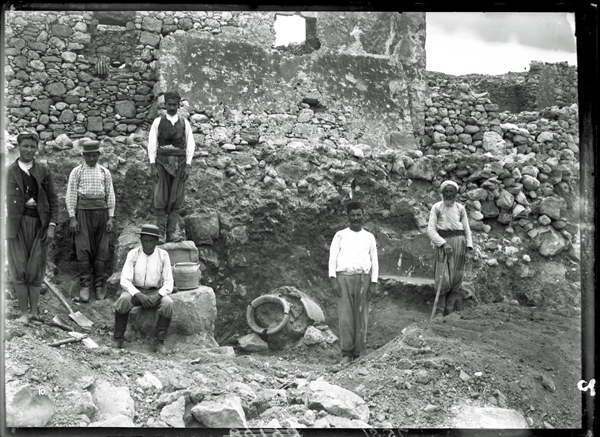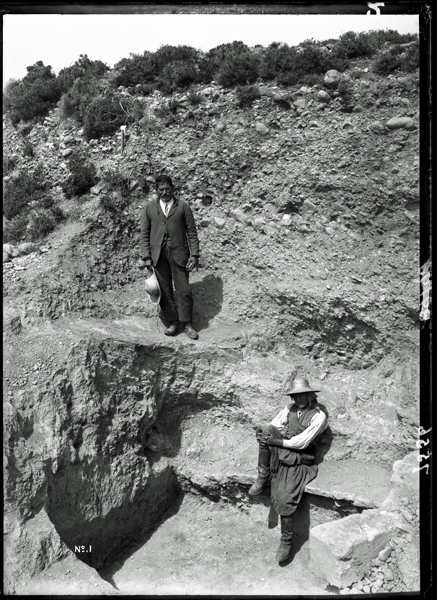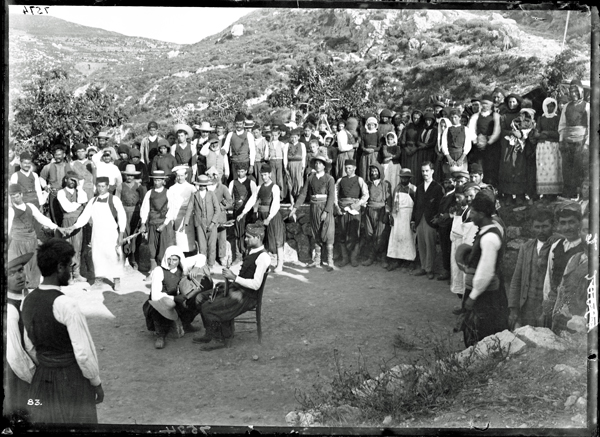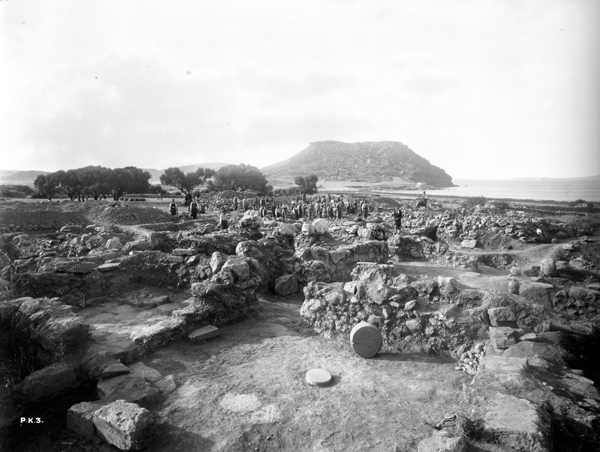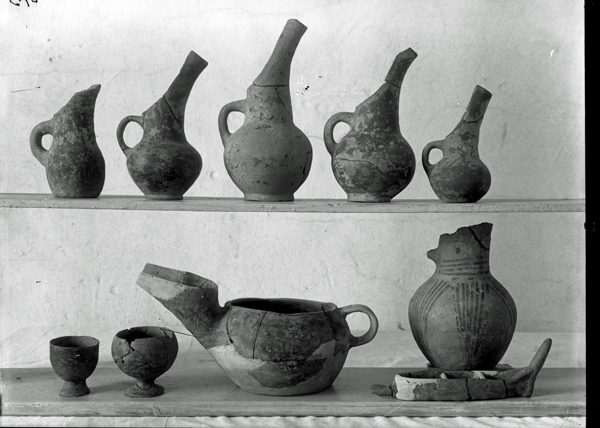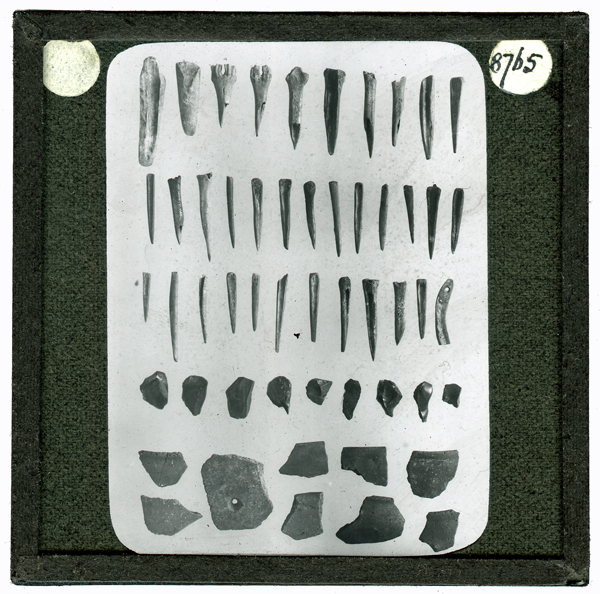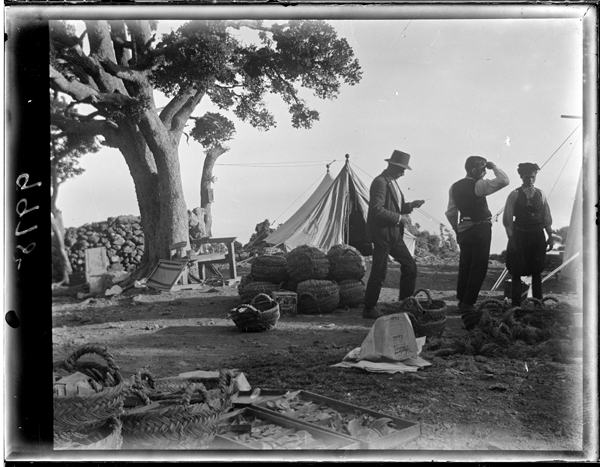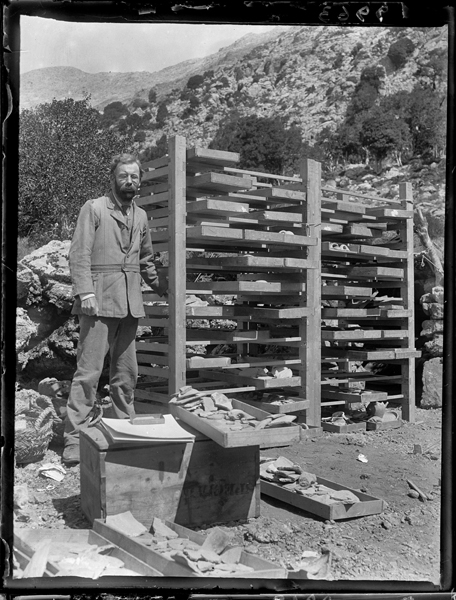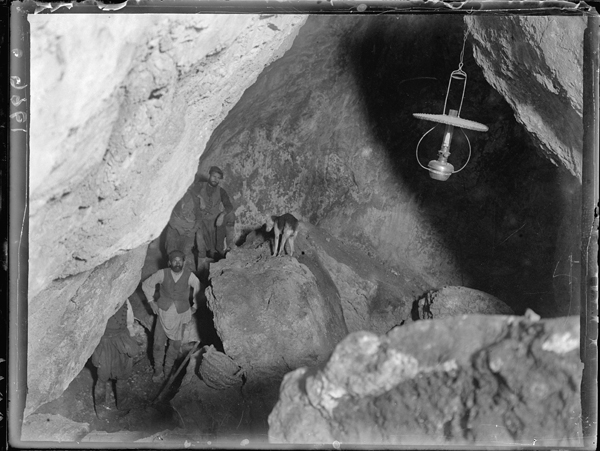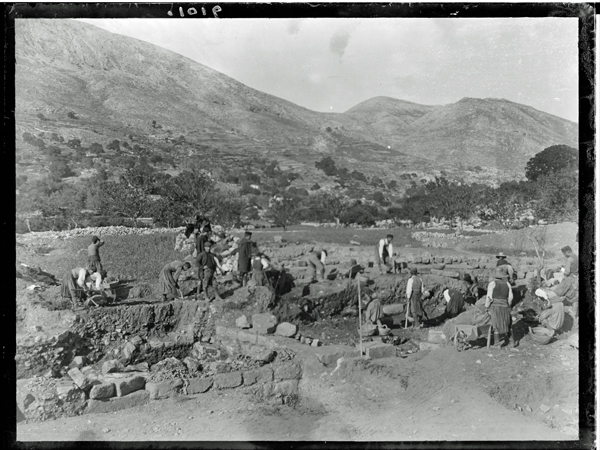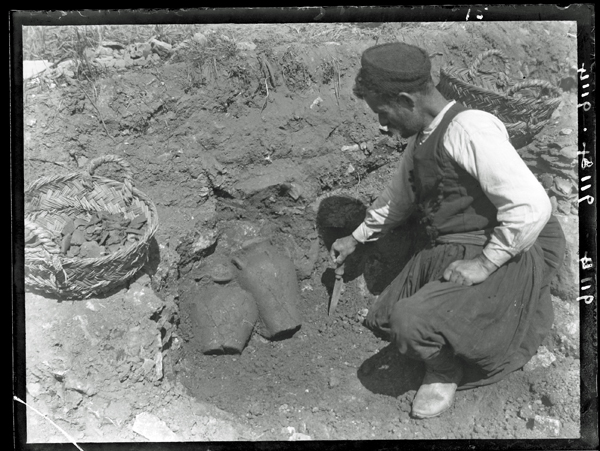Digging Crete: SPHS Images from BSA Excavations in a New Century
At the close of the Archive Story, Digging II, which chronicled the growth of British School at Athens (BSA) excavations in the late 19th century, I mentioned that the BSA had turned its sights to Crete at the beginning of the 20th century. Given the change in the political situation on the island, new opportunities for excavation had opened up. Perviously, the island had been part of the Ottoman Empire, but numerous insurrections against external rule led to an unstable situation. By 1898, the four powers of Britain, Italy, France and Russia intervened, allowing for the creation of an autonomous Cretan State, a prelude to the incorporation of Crete into the Greek State in 1913. During this interlude Arthur Evans began his excavations at Knossos in 1900. The BSA Director at the time, D.G. Hogarth, also participated in exploring the town and cemeteries around the site of Knossos during Evans’ first season. The BSA proceeded with work at Psychro Cave in 1900, then Praisos, Zakro and trial pits at Petras in 1901. Palaikastro began the following year and continued until 1906 and it proved to be a very productive area for exploration. A good portion of the funding for these early excavations came from the Cretan Exploration Fund, established initially by Arthur Evans and later managed by D.G. Hogarth (BSA Director 1897-1900).
The photographic collection of the Society for the Promotion of Hellenic Studies (SPHS) was often used by the BSA as a repository for fieldwork photographs from various excavations, including Praisos (or Praesos), Petras and Palaikastro. Unfortunately, there are no photographs from Hogarth’s excavations around Knossos, at the Psychro Cave or at Zakro in the collection. A number of these images can be found on Oxford University’s HEIR Project web-site. The BSA acquired a portion of what remained of the SPHS collection in 2003, specifically any images that documented its activities. These excavation photographs include topographic views of the areas, excavations in progress, and objects from the sites. Some of them were used as fodder for publication figures and plates. The BSA SPHS collection contains 99 photographs related to the Praisos excavation, 8 from the trial pits at Petras and 244 from Palaikastro region excavations.
Both Praisos and Petras were carried out under the directorship of R.C. Bosanquet (BSA Director 1900-1906). The bulk of the work at Praisos, from May to July 1901, was attributed to BSA students J.H. Marshall, E.S. Forster, and R. Douglas Wells (architect). In addition to excavation images from Praisos, there are scenes of an end of season festival (glendi) with music, dancing, and wrestling matches.
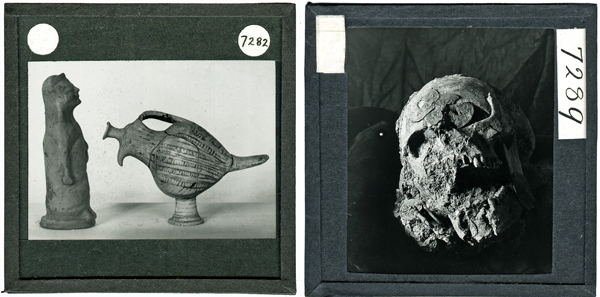
BSA SPHS 03/2866.7282 (left). Praesos: Bird vase and terracotta and BSA SPHS 03/2875.7289 (right). Praesos: Skull of a woman with silver discs over eyes
J.H. Marshall, who had trained with Arthur Evans at Knossos, appeared to be Bosanquet’s right hand man. In 1901, in addition to his work at Praisos, he was responsible for explorations in other areas of East Crete, alerting Bosanquet to sites (including Petras and Palaikastro) for possible future investigations. However, in 1902, Marshall was appointed Director-General of Archaeology in India and left the Aegean field. It was on the basis of Marshall’s surface finds that Bosanquet conducted trial excavations at Petras in June 1901.
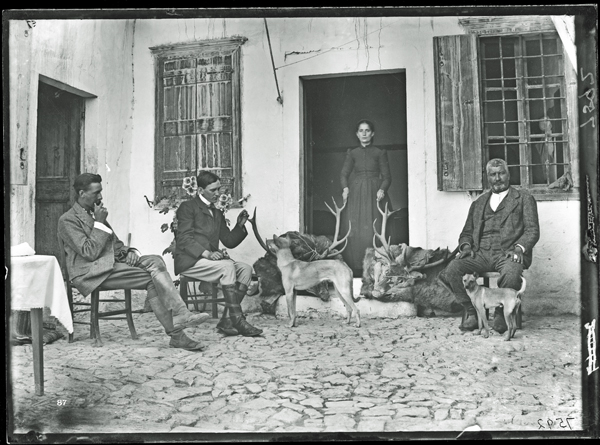
BSA SPHS 01/4999.7592. J.H. Marshall and R. Douglas Wells in the Demarch’s (Mayor’s) house in Kalmafka (Crete) during one of their explorations of the area
The larger number of images from the Palaikastro excavations span five years of work. Although the excavations were begun by Bosanquet, it was R.M. Dawkins who was given the responsibility of carrying them out. In his unpublished autobiography, Dawkins remarked that he had started at Palaikastro with very little experience other than his study of the pottery excavated by Hogarth at Zakro in the Museum in Candia (Heraklion) during the winter of 1902 (although the autobiography states 1901). He arrived at Palaikastro in March of 1903 with W.L.H. Duckworth (who would later study the skeletal material from the site). Bosanquet, considered by Dawkins to have a ‘restless spirit’, soon afterwards departed for Athens leaving Dawkins completely in charge.
The excavations of 1902-1906 cover a wide range of smaller explorations in the general Palaikastro region including Petsofa, Kastri, Ta Ellinika, Agkathia, the neolithic site of Magasa and burials in the river bank, on the cliff and in the gravel ridges. However, the bulk of the images cover the main Roussolakkos site with its Bronze Age settlement and the later Temple of Dictaean Zeus. By 1904, Dawkins was completely in charge, and the preliminary publication for this season’s work included an in-depth essay on chronology based on Evans’ work at Knossos. The captions on images of material from 1904 to 1906 reflect this change, where ‘Minoan’ was now used as a chronological marker rather than ‘Mycenaean’. These refinements and a better understanding of prehistoric chronology from Palaikastro led Dawkins (BSA Director 1906-1913) to return to Melos and re-investigate the previous BSA Phylakopi excavation in 1911 (see Archive Story, Digging II). Although there were annual preliminary reports on the Palaikastro excavations in the Annual of the British School at Athens (ABSA), the final publication only appeared years later in 1923.
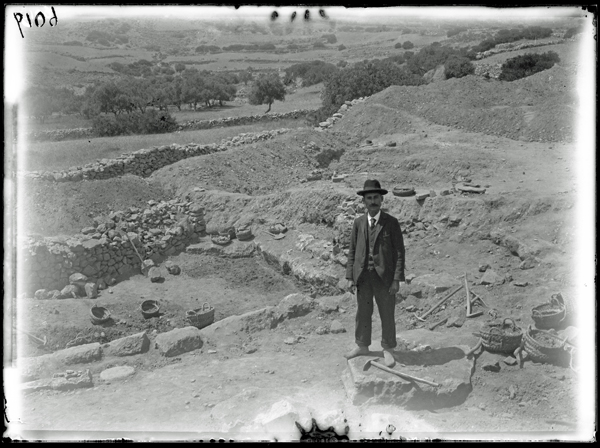
BSA SPHS 01/4900.6019. Palaikastro South Gravel Ridge: Larnakes burials with W.L.H. Duckworth (ca. 1903)
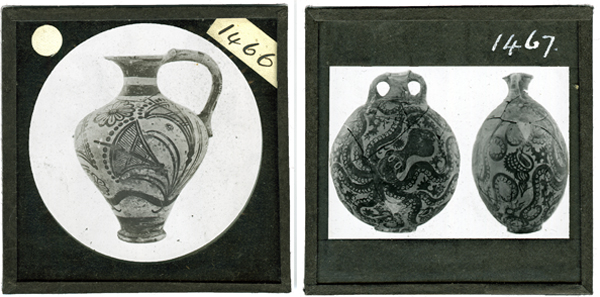
Palaikastro (Roussolakkos): BSA SPHS 03/0247.1466 (left). Jug with Floral Design and BSA SPHS 03/0249.1467 (right). Gourd Vase with Octopus Design
After Palaikastro, the BSA’s focus turned to the Greek mainland and Laconia in particular. However, BSA activity on Crete (now part of the Greek State) continued until the First World War with two short, one-season excavations by R.M. Dawkins, first at the Kamares Cave (1913) on the south slope of Mount Psiloritis and then at Plati (1914) on the Lasithi plateau. The excavations were carried out at the invitation of Dr. Hazzidakis, President of the Syllogos at Candia (i.e. the forerunner of the Archaeological Museum at Herakleion). There are 40 images from the Kamares Cave excavations and 25 images from Plati.
After WWI, Evans began making preparations to hand over his estate at Knossos to the BSA, which formally took place in 1926. Duncan Macenzie, Evans’ long-term assistant, was retained as the first Knossos Curator. He was replaced by John Pendlebury in 1929, thus firmly establishing the continuity of Knossos Curators at what is now known as the BSA Knossos Research Centre, reflecting over a century of continuous BSA activity on the island.
Deborah Harlan
British School at Athens
Images from the BSA-SPHS collection are available on the BSA’s Digital Collections page.
Click here for more BSA Archive Stories.
Further Reading:
| Knossos | |
| 1899/1900 | Hogarth, D.G. ‘Knossos. Summary Report of the Excavations in 1900: II. Early Town and Cemeteries’, ABSA 6: 70–85. |
| Psychro Cave | |
| 1900/1901 | Hogarth, D.G. ‘The Cave of Psychro in Crete’, Journal of the Anthropological Institute of Great Britain and Ireland 30: 90–91. |
| Zakro | |
| 1900/1901 | Hogarth, D.G. ‘Excavations at Zakro, Crete’, ABSA 7: 121–149. |
| Praisos | |
| 1901/1902 | Marshall, J.H. and Bosanquet, R.C. ‘Excavations at Praesos I. ABSA 8:231-270. |
| 1901/1902 | Forester, E.S. ‘Praesos. The Terra-Cottas’ ABSA 8:271-281. |
| 1904/1905 | Forster, E. S. ‘Terracotta Plaques from Praesos, East Crete’, ABSA 11:243–257. |
| 1905/1906 | Marshall, F. H. ‘Tombs of Hellenic Date at Praesos’, ABSA 12:63–70. |
| Petras | |
| 1901/1902 | Bosanquet, R. C. ‘Excavations at Petras’, ABSA 8:282–285. |
| Palaikastro | |
| 1901/1902 | Bosanquet, R. C. ‘Excavations at Palaikastro. I’, ABSA 8:286–316. |
| 1902/1903 | Bosanquet, R. C. et al. ‘Excavations at Palaikastro. II’, ABSA 9:274–387. |
| 1902/1903 | Dawkins, R. M. and Currelly, C. T. ‘Excavations at Palaikastro. III’, ABSA 10:192–231. |
| 1904/1905 | Dawkins, R. M., Hawes, C. H. and Bosanquet, R. C. ‘Excavations at Palaikastro. IV’, ABSA 11:258–308. |
| 1905/1906 | Dawkins, R. M. ‘Excavations at Palaikastro. V’, ABSA 12:1–8. |
| 1923 | Bosanquet, R. C. and Dawkins, R. M. The Unpublished Objects from the Palaikastro Excavations: 1902-1906. London: British School at Athens (British School at Athens Supplementary Papers, 1). |
| Kamares Cave | |
| 1912/1913 | Dawkins, R. M. & Laistner, M. L. W. ‘The Excavation of the Kamares Cave in Crete’, ABSA 19: 1–34. |
| Plati | |
| 1913/1914 | Dawkins, R. M. (1913) ‘Excavations at Plati in Lasithi, Crete’, ABSA 20: 1–17. |
